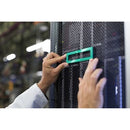Description
HPE Fan Assembly
Introducing the HPE Fan Assembly, a precision-engineered cooling module designed to protect and optimize performance for HP ProLiant servers and other HPE platforms. This hot-swappable, plug-and-play fan tray provides reliable airflow management across server blades and chassis, ensuring consistent temperatures even under heavy workloads. By replacing a failed or aging fan with this authentic HPE component, data centers reduce the risk of thermal throttling, extend the life of critical hardware, and maintain peak I/O throughput through improved thermal efficiency. Built to meet HPE's exacting standards for reliability and compatibility, the fan assembly integrates with existing thermal management systems, supports intelligent fan control, and delivers dependable operation in high-density environments. In busy data centers where uptime is essential, this replacement part helps technicians minimize downtime during maintenance windows and simplifies inventory management with a straightforward service procedure. Whether you're upgrading an older server, performing proactive maintenance, or stocking spare parts, the HPE Fan Assembly combines precision engineering with durable materials to deliver long-lasting cooling performance and peace of mind.
- The HPE Fan Assembly delivers superior cooling performance to maintain optimal operating temperatures across critical server components, helping prevent thermal throttling and preserving CPU and memory efficiency even under peak loads. With a design tuned for HPE systems, it ensures consistent airflow and balanced thermal distribution to support high-performance workloads, virtualization, and data-intensive applications.
- Built for reliability and ease of maintenance, this fan tray is engineered for durability in data center environments. Its robust construction resists vibration and dust ingress, while a modular, hot-swappable design minimizes downtime during replacement. Field technicians benefit from straightforward service procedures and minimal single-point failure risk in multi-node configurations.
- Efficient power and intelligent control capabilities help manage fan speed according to real-time thermal demands. By dynamically adjusting RPMs, the HPE Fan Assembly reduces energy consumption, lowers overall server power usage, and helps keep operating noise at acceptable levels in both dedicated data centers and quieter office environments where HP servers are deployed.
- Easy installation and compatibility are key advantages. The fan assembly is designed to align with standard HPE chassis mounting points and connectors, enabling quick replacement without specialized tools. This plug-and-play approach supports proactive maintenance strategies, reduces labor time, and ensures consistent performance across in-service servers and upgrades.
- Value and support you can trust. As a genuine HPE replacement part, the fan assembly is backed by HP’s quality standards and access to enterprise-level parts channels. This translates to dependable availability, predictable replacement costs, and confidence that the component will integrate with firmware, management consoles, and diagnostic tools used in modern data centers.
Technical Details of HPE Fan Assembly
- Note: Specifications vary by model and SKU; verify exact data using your UPC/SKU in the official HPE catalog or supplier portal for voltage, RPM range, connector type, dimensions, and compatibility.
how to install HPE Fan Assembly
- Power down the server and unplug all power sources; ground yourself to prevent electrostatic discharge before handling internal components.
- Remove the server cover or access panel as specified in the official service manual, and locate the existing fan assembly within the chassis or blade enclosure.
- Disconnect any fan harnesses or cables carefully, noting connector orientation to ensure proper reattachment with the new unit.
- Remove mounting screws or latches securing the old fan assembly, then lift it out of the chassis without applying excessive force to adjacent components.
- Align the new HPE Fan Assembly with the mounting points and secure it firmly using the original screws or latches. Reconnect all power and control cables, ensuring firm connections and correct routing away from fans’ moving parts.
- Replace the chassis cover, reconnect power, and boot the server. Use the system BIOS/IDRAC diagnostics to confirm that all fans are detected, operating within expected RPM ranges, and reporting normal temperatures under load tests.
- Perform a final validation run with standard workloads to verify stable performance, and document the replacement in your maintenance logs to support ongoing uptime and warranty compliance.
Frequently asked questions
- Q: Is the HPE Fan Assembly compatible with all HPE servers? A: Compatibility depends on the specific server model and chassis type. This replacement part is intended to replace designated HPE fan modules in supported ProLiant and related server families. Always verify your server model, chassis, and part number before purchasing.
- Q: How do I know if my fan assembly needs replacement? A: Symptoms include unusual fan noise, inconsistent or abnormal RPM readings in system management tools, rising coolant or component temperatures, and audible alarms from iLO/IDRAC. If you observe any of these indicators, consult the server’s service manual and run recommended diagnostics to confirm the fault.
- Q: Does this fan come with a warranty? A: Warranty terms vary by region and supplier. When purchased through official HP channels or authorized distributors, replacement parts typically carry a standard hardware warranty aligned with enterprise procurement policies. Check your purchase agreement for exact coverage details.
- Q: Can I replace the fan assembly without powering down the server? A: Replacement procedures depend on the chassis and model. Some configurations support hot-swappable operations, while others require a complete power-down. Always follow the official service procedure for your specific model to avoid damage and ensure safety.
- Q: What maintenance steps should accompany a fan replacement? A: After installation, verify fan operation, check for proper cable routing, and update system firmware if applicable. Perform a post-installation thermal test under load to confirm cooling performance remains within specification and document results for audit and support purposes.
Customer reviews
Showing - Of Reviews


